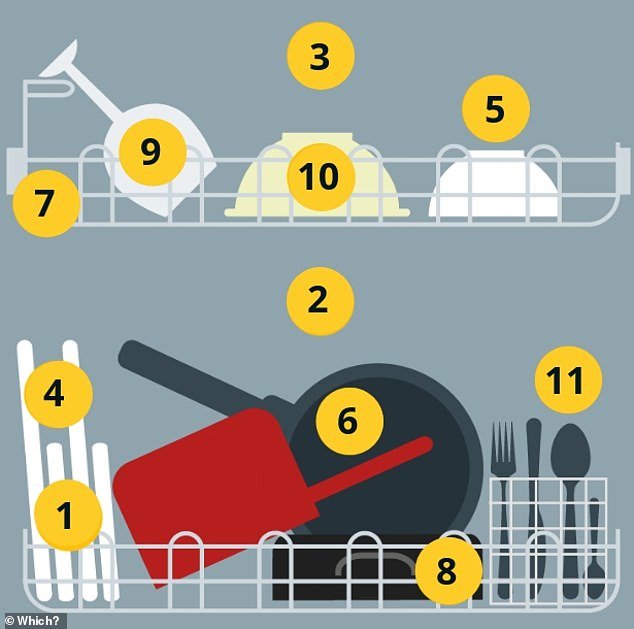It’s a chore that many people dread.
But loading your dishwasher is about to get a lot easier, following new advice from Which?.
The UK’s consumer champion has released an 11-step guide on how to load your dishwasher.
From making sure your plates face the middle, to mixing up plates and bowls, it turns out you’ve probably been doing it wrong this whole time.
Which?’s guide also finally settles the debate on whether or not you should be pre-rinsing your dishes.
‘The way you load your dishwasher can make a big difference to how efficiently it cleans your dishes, especially bigger items and those covered in tough-to-shift grime,’ Which? said.
So, have you been loading your dishwasher using the most efficient technique?
Here’s what Which? says you should be doing in your kitchen.

It’s a chore that many people dread. But loading your dishwasher is about to get a lot easier, following new advice from Which?
1. Don’t rinse your plates
Contrary to popular belief, Which? says you should not rinse your plates before popping them in the dishwasher.
‘Knocking off lumps of leftover food before loading the dishwasher will give it best chance of getting everything clean,’ it explained.
‘But most dishwasher programs will pre-rinse your dishes, so you don’t need to run them under the tap – it’s a waste of water.’
2. Make sure your dishes are all facing the middle
Which? advises that the dirty side of every dish should face the middle of the dishwasher rack.
‘The jet spray from the dishwasher arms comes out like a garden sprinkler, so make sure it won’t be blocked, or facing away,’ it said.
3. Don’t overload your dishwasher

From making sure your plates face the middle, to mixing up plates and bowls, it turns out you’ve probably been doing it wrong this whole time
While you might be tempted to chuck all your dirty plates in at once, Which? says that it’s important not to overload your dishwasher.
‘Sticking to the spaces provided in the dish racks and cutlery baskets is a good idea,’ it explained.
‘Overloading your dishwasher will make it more difficult for it to get everything clean.’
4. Mix up plates and bowls
Instead of stacking your plates at one end and your bowls at the other, Which? says it’s best to mix your crockery up in the dishwasher.
‘Leaving spaces between dishes and cutlery allows the water and detergent to spread around,’ Which? said.
‘You could even try alternating between larger and smaller plates next to each other to help with this.’
5. Make sure bowls are facing down

Contrary to popular belief, Which? says you should not rinse your plates before popping them in the dishwasher
As obvious as it sounds, make sure your bowls are facing down, or you’ll open your dishwasher to find them full of water.
6. Place large items at the back and sides
Whether it’s a baking tray or a fruit bowl, make sure you place any large items at the back and sides of your dishwasher.
‘This will make sure they don’t get in the way of the flow of water and detergent, preventing other dishes getting clean,’ Which? said.
7. Use adjustable racks for large items
If your dishwasher has an adjustable top rack, this can be useful for fitting in large items or long-stemmed wine glasses, according to Which?.
‘To check if your dishwasher has an upper rack that can be lowered or raised, look out for a lever mechanism on the sides,’ Which? said.
‘Some also use a runner system that requires the basket to be removed and the runners to be adjusted.’
8. Place roasting trays on the bottom rack
Roasting trays are best placed on the bottom rack where the water pressure and temperature are highest.
Which? added: ‘Some dishwashers have a separate spray-head for heavy-duty jobs like this.’
9. Places glasses at the side and mugs in the middle
While all cups and glasses should go on the top, facing down, Which? advises paying careful consideration to where different vessels are placed.
‘Put glasses along the side supports if possible, as the water jet isn’t so powerful here. Cups and mugs can go in the middle,’ it said.
10. Put plastic items on the top rack
To safeguard any plastic items, Which? says you should place these in the top rack only.

Which? advises mixing up the orientation of your cutlery to prevent an issue it terms ‘nesting’
‘The temperature is lower here, so there’s less chance of them warping or becoming misshapen in the heat,’ it explained.
11. Mix up the orientation of your cutlery
Finally, Which? advises mixing up the orientation of your cutlery to prevent an issue it terms ‘nesting’.
‘The reason your cutlery doesn’t always get clean could be because like-for-like items are sitting too close together, meaning there’s no space for the water,’ it explained.
‘This issue, known as nesting, can happen when spoons lean into each other.
‘To solve this, place some upright and some facing downwards, so that water can rinse over all surfaces.
‘The exception to this rule are knives. It’s safer to just load them pointy-side down.’
